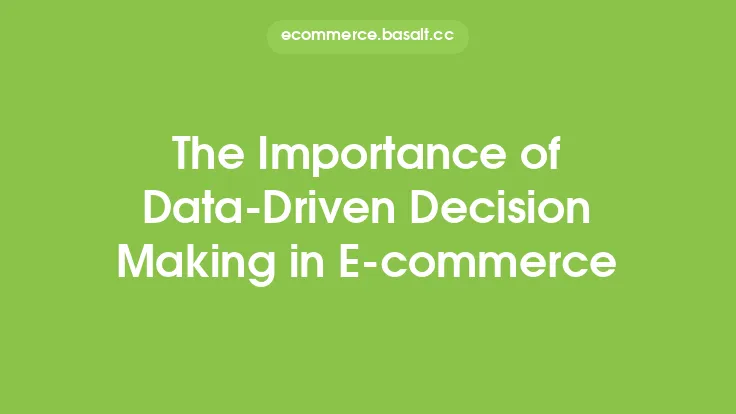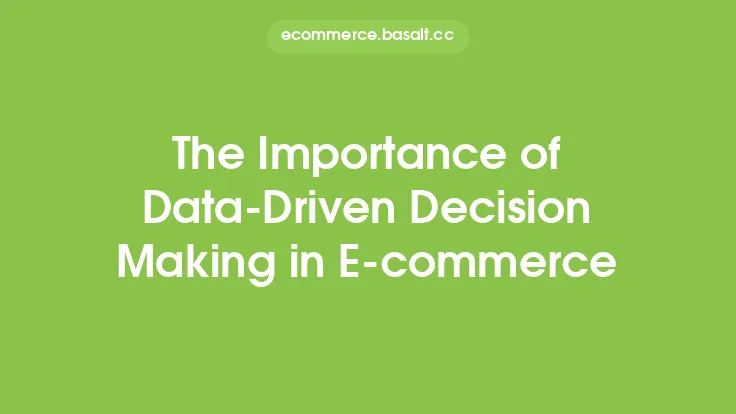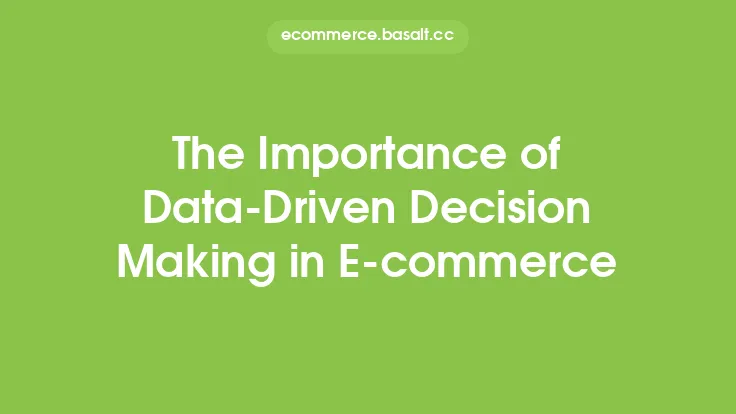In the world of e-commerce, decision-making is a crucial aspect that can make or break a business. With the vast amount of data available, it's essential to have a solid understanding of analytics to inform these decisions. E-commerce analytics provides insights into customer behavior, sales trends, and market dynamics, enabling businesses to optimize their strategies and stay ahead of the competition. In this article, we'll delve into the importance of analytics in e-commerce decision-making and explore how it can help businesses drive growth and success.
Introduction to E-commerce Analytics
E-commerce analytics involves the collection, analysis, and interpretation of data related to online sales, customer interactions, and market trends. This data can come from various sources, including website traffic, social media, customer reviews, and sales transactions. By analyzing this data, businesses can gain a deeper understanding of their customers' needs, preferences, and behaviors, which can inform product development, marketing strategies, and customer service initiatives. E-commerce analytics can be categorized into two main types: descriptive analytics and predictive analytics. Descriptive analytics focuses on historical data, providing insights into what has happened, while predictive analytics uses statistical models and machine learning algorithms to forecast what may happen in the future.
The Role of Analytics in E-commerce Decision Making
Analytics plays a vital role in e-commerce decision-making, as it provides businesses with the insights they need to make informed decisions. By analyzing data on customer behavior, sales trends, and market dynamics, businesses can identify areas of opportunity and optimize their strategies to drive growth and success. For example, analytics can help businesses determine which products to stock, how to price them, and which marketing channels to use to reach their target audience. Additionally, analytics can help businesses identify and mitigate potential risks, such as inventory shortages or supply chain disruptions. By leveraging analytics, businesses can make data-driven decisions that drive revenue growth, improve customer satisfaction, and increase competitiveness.
Key Benefits of E-commerce Analytics
The benefits of e-commerce analytics are numerous and well-documented. Some of the key benefits include:
- Improved decision-making: Analytics provides businesses with the insights they need to make informed decisions, reducing the risk of costly mistakes and improving overall performance.
- Enhanced customer experience: By analyzing customer behavior and preferences, businesses can tailor their products and services to meet their needs, improving customer satisfaction and loyalty.
- Increased revenue: Analytics can help businesses identify opportunities to increase revenue, such as optimizing pricing, improving product placement, and targeting high-value customer segments.
- Better resource allocation: Analytics can help businesses allocate resources more effectively, reducing waste and improving efficiency.
- Competitive advantage: Businesses that leverage analytics can gain a competitive advantage over their rivals, staying ahead of the curve and driving innovation.
Common E-commerce Analytics Tools and Techniques
There are many e-commerce analytics tools and techniques available, each with its own strengths and weaknesses. Some of the most common tools include:
- Google Analytics: A popular web analytics platform that provides insights into website traffic, behavior, and conversion rates.
- Adobe Analytics: A comprehensive analytics platform that provides insights into customer behavior, sales trends, and market dynamics.
- Data visualization tools: Tools like Tableau, Power BI, and D3.js that help businesses visualize and interpret complex data sets.
- Machine learning algorithms: Techniques like clustering, decision trees, and neural networks that help businesses predict customer behavior and identify patterns in large data sets.
- A/B testing and experimentation: Techniques that involve testing different versions of a product or service to determine which one performs better.
Best Practices for Implementing E-commerce Analytics
Implementing e-commerce analytics requires a strategic approach, as businesses need to ensure that they are collecting and analyzing the right data, and using it to inform decision-making. Some best practices for implementing e-commerce analytics include:
- Define clear goals and objectives: Businesses should define clear goals and objectives for their analytics initiatives, ensuring that everyone is aligned and working towards the same outcomes.
- Collect and integrate data from multiple sources: Businesses should collect and integrate data from multiple sources, including website traffic, social media, customer reviews, and sales transactions.
- Use data visualization techniques: Businesses should use data visualization techniques to help interpret and communicate complex data sets.
- Continuously monitor and evaluate performance: Businesses should continuously monitor and evaluate performance, using analytics to identify areas of opportunity and optimize their strategies.
- Foster a culture of data-driven decision-making: Businesses should foster a culture of data-driven decision-making, encouraging employees to use analytics to inform their decisions and drive business outcomes.
Overcoming Common Challenges in E-commerce Analytics
Despite the many benefits of e-commerce analytics, there are several common challenges that businesses may face. Some of these challenges include:
- Data quality and integrity: Businesses may struggle with data quality and integrity issues, such as missing or duplicate data, which can impact the accuracy of their analytics.
- Data overload: Businesses may be overwhelmed by the sheer volume of data available, making it difficult to identify the most relevant and actionable insights.
- Lack of skills and expertise: Businesses may lack the skills and expertise needed to collect, analyze, and interpret complex data sets.
- Limited resources: Businesses may have limited resources, including budget, personnel, and technology, which can limit their ability to implement and maintain effective analytics initiatives.
- Ensuring data privacy and security: Businesses must ensure that they are collecting, storing, and analyzing data in a way that is secure and compliant with relevant regulations, such as GDPR and CCPA.
Future of E-commerce Analytics
The future of e-commerce analytics is exciting and rapidly evolving. Some of the key trends and developments that are shaping the future of e-commerce analytics include:
- Artificial intelligence and machine learning: The use of AI and machine learning algorithms to analyze and interpret complex data sets, and predict customer behavior.
- Internet of Things (IoT) data: The integration of IoT data into e-commerce analytics, providing insights into customer behavior and preferences in the physical world.
- Augmented reality and virtual reality: The use of AR and VR to create immersive and interactive customer experiences, and provide new insights into customer behavior and preferences.
- Blockchain and distributed ledger technology: The use of blockchain and distributed ledger technology to provide secure and transparent data storage and analysis.
- Cloud-based analytics: The use of cloud-based analytics platforms to provide scalable, flexible, and cost-effective analytics solutions.





